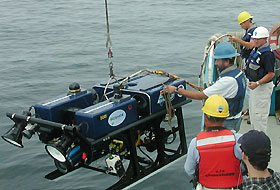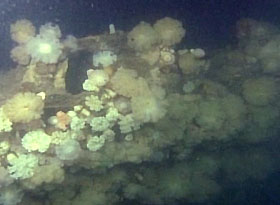|
This is an archived article.
For the latest news, go to the Advance Homepage
For more archives, go to the Advance Archive/Search Page. |
||||
|
Research Vessel Crew Help
Had it not been for the expertise and dedication of UConn staff and crew, the mission to better understand two of New England's maritime mysteries might not have succeeded last month.
The RV Connecticut became the floating base of operations for two dozen scientists, educators, and journalists investigating the 1898 sinking of the steamship Portland, sometimes referred to as New England's version of the Titanic, and a collision four years later between two schooners described as the "supertankers" of their time. The wrecks lie close together within the Stellwagen Bank National Marine Sanctuary off Gloucester, Mass. Ivar Babb, director of the National Undersea Research Center, worked closely with the National Oceanic and Atmospheric Administration and The Discovery Science Channel to plan and execute the mission. It was his second trip to the Portland wreckage. Babb says that last year, the identity of a wreck believed to be the steamship Portland was confirmed. This time, using improved technology, the goal was to conduct a much more systematic baseline mapping of the wreck, and perhaps determine and document what caused the ship to sink. The steamship, headed for Portland, Me., from Boston, went down on a stormy November night, taking all 192 passengers and crew with it. But questions have remained: Did the ship capsize or break apart? Did the steamer's two boilers explode? Or, after a narrow miss with one ship, did the Portland collide with another? The National Undersea Research Center planned to use a new remotely operated vehicle for the dives to search for clues. The unmanned submersible, about the size of a refrigerator, was so new, it was not delivered to the Avery Point campus until the day before the Connecticut was scheduled to sail, leaving no time for tests to ensure that the technical bugs had been worked out. When the crate was opened, Babb's group discovered it had been dropped during shipping. The thrusters, used to maneuver the vehicle underwater, had been shirred off. And when the ship arrived in Gloucester to pick up the scientists, the UConn technicians discovered the control box, used to pilot the vehicle, had been severely damaged as well. "We would never have made it, had it not been for the Herculean effort by the UConn marine sciences machine shop and our technicians, who worked all kinds of extra hours to complete the critical repairs," Babb says. With the threat of a hurricane bearing down on New England, the Connecticut set out for the wreckage site. The remotely operated vehicle had been outfitted with a special 1000-watt, high intensity lighting system, and high definition video cameras supplied by The Discovery Science Channel. Babb says the whole group was excited about the sharp, vivid images coming from the seafloor. The pictures richly detailed the bow, which is still intact. Other images of the galley and a storeroom captured the grandeur that once was the Portland, with its fine china and yellowish ceramic pottery. During the second day at the site, however, the bar that supported the submersible's lighting became entangled with the wreckage, which over the past century had become festooned with lost fishing gear. To rescue it, the pilot of the remotely operated vehicle, Craig Bussell, and Dennis Arbidge, its navigator, worked with the ship's captain, Dan Turner, who used the Connecticut's dynamic positioning system to maneuver a few meters at a time away from the wreck to dislodge the remotely operated vehicle. Fortunately, says Babb, they were able to recover the equipment. And a call to a Gloucester marine repair shop while steaming back to port resulted in quick overnight repairs. On day four of the mission, the team turned its sights about two miles away to the pair of Boston-bound schooners that had collided and sunk to the ocean floor. The Frank A. Palmer and the Louise B. Crary, two of the largest schooners of their time, were both carrying coal. Marine historians believe the Palmer was headed south toward Boston Harbor and had the right of way. Side scan sonar used during last year's mission determined where the two ships went down. This time, the very first video images captured the fallen masts and rigging, the rudder, and sternpost. But within minutes, through the murky water it became clear that the rest of the wreckage had become a graveyard for dozens of fishing nets. The team decided to pull back. "We decided that discretion was the better part of valor. The wreckage was just too dangerous with the fishing gear wrapped around it," says Babb. Facing increasing seas and winds from Hurricane Isabel, the group quickly moved on to another wreck that turned out to be a 19th-century schooner. Babb described the site as a mini- time capsule. "We came across some well-preserved artifacts, including medicine bottles, smoking pipes that may have been used by the captain, and an old style speedometer called a patent log." The group cut short its mission by a day, to avoid the remnants of the hurricane. In early November, the expedition team will present its findings at a news conference in Portland. And in January 2004, the Science Channel will air a documentary it produced called "Science of the Deep: The Wreck of the Portland." |
 he remnants
of Hurricane Isabel, decades of lost fishing gear,
and damaged equipment all threatened disaster for
the latest underwater expedition undertaken by the
National Undersea Research Center at UConn and the
University's research vessel.
he remnants
of Hurricane Isabel, decades of lost fishing gear,
and damaged equipment all threatened disaster for
the latest underwater expedition undertaken by the
National Undersea Research Center at UConn and the
University's research vessel.


